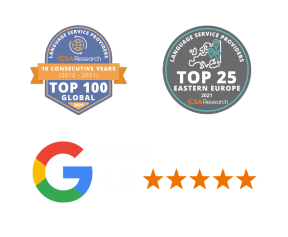CAT Tools

To ensure that your translated documents are free from errors and returned within the agreed deadline, we use the latest technologies to assist our work. We use a form of software known as Computer-Assisted Translation (CAT) in our work.


Check out what it is and why we use it!
Also, if you need a professional translator for your next project, then you should choose us. Our team of specialists work in over 100 language pairs, and we are always more than happy to help you!
What is a CAT tool?
This is a type of computer assisted translation tool that is often used by language professionals. It aids in the process of translating a text from one language to another. Its purpose is to enhance the speed and accuracy of translations, extending the abilities of the translator.
The core functionality of a CAT tool revolves around the translation memory (TM) it uses or generates. This is a database that stores sentences, paragraphs, and segments from one translation so they can be used in other ones. When a translator is working on a text, the CAT tool checks its TM for similar or identical matches. These can then be reused or adapted to save time and ensure consistency in the style and terminology used across a whole project.
CAT tools also offer a range of other functionalities to support the translation process. These include integrated dictionaries and glossaries, spelling checkers, and grammar analysis tools. Some programmes offer real-time collaboration, which is particularly beneficial for large-scale or team-based translation projects.
Are CAT tools the same as Machine Translation?
It is worth noting that CAT tools are distinct from machine translation software, such as Google Translate. While machine translation automatically translates text without human input, we use CAT tools as an aid in our work. This blend of technology and human expertise assures accurate translations that surpass machine translation in complex or subject-specific texts.
The history of CAT tools
The development of CAT tools began during the Cold War. They were originally part of an effort by the US military to decode communications from the USSR. The concept of machine translation also emerged around this time, first being mentioned in 1947 by Warren Weaver.
CONTACT US FOR A FREE QUOTE!
One of the earliest systems was Systran, created in 1968 by an American researcher, Dr. Peter Toma, which proved invaluable to the US Air Force in deciphering Russian reports. Despite the initial scepticism in the late 1960s and early 1970s about machines replacing human translators, the focus shifted to how could such programmes assist them in their work.
The 1980s saw the development of more advanced CAT tools that integrated useful features like translation memories and terminology databases. However, the high costs initially slowed down any widespread adoption.
The 1990s marked a significant turning point, as technological advancements began to make these tools more affordable. This led to their increased popularity and adoption across many industries, including those run by large corporations, while positively influencing the work of freelance translators.
What is the difference between CAT and TMS?
CAT and TMS (translation management system) tools, while often used together, actually serve distinct functions in the translation process.
A CAT tool is used directly by translators to facilitate the actual task of translating texts, and includes both translation memory tools and terminology databases.
A TMS is a more comprehensive system, as its role is to manage the entire translation workflow. It helps with translation project management, workflow automation, team collaboration, and tracking.
A TMS may integrate various CAT tools to facilitate assigning tasks to translators, tracking progress, and managing deadlines. It is particularly useful in large projects for translation agencies that handle multiple tasks simultaneously and require easy translation memory management.



Popular CAT tools
The market today offers a diverse range of CAT tools. Each caters to the specific needs of different translators and translation agencies. Here is a brief overview of some of the common CAT tools in the market, as used by professional translators as well as beginners.
SDL Trados Studio is one of the most widely used CAT tools. It offers advanced features, including translation memory, terminology management, and automated quality checks. It is popular among freelance translators and large agencies.
MemoQ is a versatile tool that is favoured for its user-friendly interface. This includes translation memory, term bases, and an integrated CAT tool environment. The robust project management features cater well for translation teams.
Wordfast is well known for its compatibility with Microsoft Word documents. It offers translation memory and terminology management in a familiar word-processing environment. It is also a fast and cost-effective solution, suitable for translators who prefer working within the Microsoft Office suite.
OmegaT is an open-source tool written in Java. It is a free and customisable type of software that you can use with your own translation memories. It features standard CAT functionalities, translation memories and glossaries, and supports a wide range of file formats.
Across is another comprehensive CAT tool aimed at enterprises and translation agencies. It offers project management, translation memories, and quality management. The software easily handles complex translation workflows and large-scale projects.
Déjà Vu is designed for professional translators, offering a complete suite of translation tools, including translation memories, terminology management, and a project management system. It is valued for its advanced data import and export capabilities, as well as its support for a wide range of formats.
MateCat is a web-based CAT tool that provides a translation memory and the possibility of real-time collaboration. It is particularly popular for its user-friendly interface and cloud-based operation, allowing for easy access.
XTM Cloud is another cloud-based tool that combines a translation memory, term base, and project management features. It is designed for collaborative work and offers a range of automation tools to accelerate the workflow process.
Choosing the best CAT tool
To choose the best CAT tool, first assess the software’s compatibility with the file formats you commonly use. This will ensure smooth integration of your documents into the translation workflow. It is good to look for a tool that supports your industry-specific formats.
Check out the user interface and test it, if this is possible. A tool with an intuitive, user-friendly interface significantly reduces the learning curve and increases productivity.
Advanced features, including real-time collaboration, cloud-based functionality, and project management tools all greatly facilitate team projects. Lastly, consider the support, as a tool that offers regular updates and the ability to handle the increasing volumes of work as your needs grow is a valuable long-term investment.
How does a CAT tool work?
At the core of most CAT tools is a database that stores previously translated source texts and their corresponding translations in a target language. When a translator works on a new project, the CAT tool scans the text for segments (phrases, sentences, or paragraphs) that match or closely resemble entries in the TM. If a match is found, the tool suggests these previously translated segments to the translator. This accelerates the translation process by avoiding re-translation of the same or similar texts.
In practice, CAT software includes an interactive interface where you can view the source text and the suggested translations strings, side-by-side. As you progress through the text, the software continuously provides suggestions that can be accepted, modified, or rejected based on the context.
Many CAT tools are equipped with a terminology database or glossary. This feature reinforces the consistent use of specialised terms, industry-specific jargon, and company-specific language. It is particularly beneficial in technical, legal, or medical translations.
Some computer-assisted translation tools enhance this process further with integrated linguistic databases. As the translations progress, they offer synonyms, definitions, and context examples. They may also include spelling-checkers and grammar analysis tools.
What are the benefits of CAT Tools?
CAT tools increase the efficiency of the translation process by reducing the time and effort needed to translate the repetitive content that occurs in projects. This feature is invaluable for large projects, especially those with tight deadlines. The improved quality and consistency of the translations made with CAT tools help to enhance client satisfaction. This is why many language service providers prefer working with such tools.
Quality assurance features
The quality assurance features in CAT tools enhance the overall quality of the translated material, helping to exclude any inconsistencies. Automated error-checking identifies potential issues in the translated text, which may include spelling, punctuation or grammatical errors. Version control and the ability to track changes allow for a detailed review of what modifications have been made, by whom, and when in collaborative translation projects. Many CAT tools also include the possibility of directly integrating client or reviewer feedback.
Why do we use CAT Tools at Skrivanek?
We utilise CAT tools at our agency because they significantly enhance the value we deliver to our clients. They enable us to provide translations that are both highly accurate and consistent across various documents.
The efficiency of CAT tools reduces turnaround times, allowing our project managers to meet tight deadlines without compromising quality. This quality assurance helps us by minimising errors and maintaining our high standards.
Contact us for a quote!
WHAT OUR CUSTOMERS SAY ABOUT US
Vielen Dank für Ihre qualifizierten Übersetzungen und die hervorragende Kundenbetreuung.
Herzlichen Dank für die sehr gute und nette Zusammenarbeit!
Ich empfinde die Zusammenarbeit mit Skrivanek als höchst angenehm. Skrivanek reagiert immer vorbildlich!
Rasch, zuverlässig, kunden- und lösungsorientiert, sehr engagiert. Wir schätzen die Zusammenarbeit mit Skrivanek sehr.
Vielen Dank für die perfekte Unterstützung & tolle Zusammenarbeit in den vergangenen Jahren! Wir freuen uns auf die kommenden Jahre… weiter so!
Super schnelle Bearbeitung und immer bestens informiert!
Alles Bestens, entsprechend erhalten Sie von uns auch viele Aufträge!
Sehr schnelle Reaktionszeit, klare Fristen und deren Einhaltung.
NEARLY 30 YEARS OF EXPERIENCE!
We provide professional translations that meet the highest quality standards.
100+
language combinations in portfolio
100%
of our clients would recommend us
50+
fields of expertise


